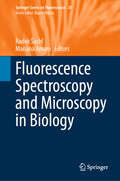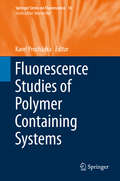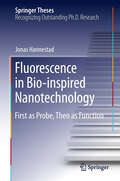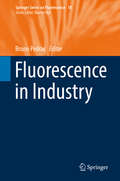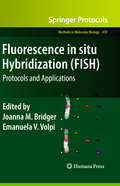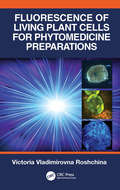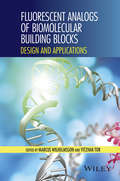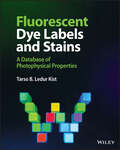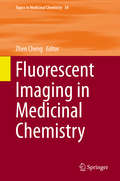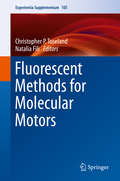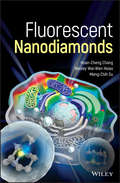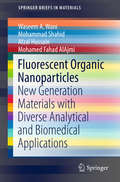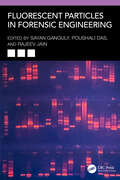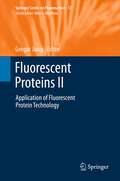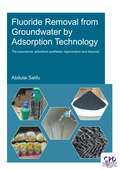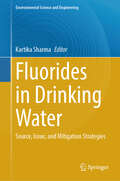- Table View
- List View
Fluorescence Spectroscopy and Microscopy in Biology (Springer Series on Fluorescence #20)
by Radek Šachl Mariana AmaroThis book provides the reader with an updated comprehensive view of the rapidly developing and fascinating field of fluorescence spectroscopy and microscopy. In recent years, fluorescence spectroscopy and microscopy have experienced rapid technological development, which has enabled the detection and monitoring of single molecules with high spatial and temporal resolution. Thanks to these developments, fluorescence has become an even more popular method in physical, biological and related fields. This book guides the reader through both basic and advanced fluorescence spectroscopy and microscopy approaches with a focus on their applications in membrane and protein biophysics. Each of the four parts: A - Fluorescence Spectroscopy, B - Fluorescence Microscopy, C - Applications of Fluorescence Spectroscopy and Microscopy to biological membranes and D - Applications of Fluorescence Spectroscopy to protein studies are written by experts within the field. The book is intended for both complete beginners who want to quickly orient themselves in the large number of existing fluorescent methods, as well as for advanced readers who are interested in particular methods and their proper use.
Fluorescence Studies of Polymer Containing Systems
by Karel ProcházkaThis volume describes the application of fluorescencespectroscopy in polymer research. The first chapters outline the basicprinciples of the conformational and dynamic behavior of polymers and reviewthe problems of polymer self-assembly. Subsequent chapters introduce the theoreticalprinciples of advanced fluorescence methods and typical examples of theirapplication in polymer science. The book closes with several reviews of variousfluorescence applications for studying specific aspects of polymer-solution behavior. It is a useful resource for polymerscientists and experts in fluorescence spectroscopy alike, facilitating theircommunication and cooperation.
Fluorescence in Bio-inspired Nanotechnology: First as Probe, Then as Function
by Jonas HannestadIn his thesis Fluorescence in Bio-inspired Nanotechnology, Jonas Hannestad describes the evolving field of DNA nanotechnology in a lucid and easily accessible way. A central theme in the thesis is how biological structures and mechanisms constitute a basis for the design of novel technologies. Hannestad discusses how self-assembled, nanometer-scale DNA constructs can be functionalized using fluorescent labeling. In particular, he highlights how applications are based on fluorescence resonance energy transfer (FRET). Another important contribution is the development of a lipid monolayer platform for the step-by-step assembly of DNA nanoconstructs. The work in the thesis is based on five peer-reviewed papers published in high-profile journals, all of which involve major contributions from the author.
Fluorescence in Industry (Springer Series on Fluorescence #18)
by Bruno PedrasThis book gathers 12 outstanding contributions that reflect state-of-the-art industrial applications of fluorescence, ranging from the pharmaceutical and cosmetics industries to explosives detection, aeronautics, instrumentation development, lighting, photovoltaics, water treatment and much more. In the field of fluorescence, the translation of research into important applications has expanded significantly over the past few decades. The 18th volume in the Springer Series on Fluorescence fills an important gap by focusing on selected industrial applications of fluorescence, described in contributions by both industry-based researchers and academics engaged in collaborations with industrial partners.
Fluorescence in situ Hybridization (FISH)
by Keith Morris Joanna M. BridgerThe design simplicity and cost-effectiveness of the early Fluorescence in situ Hybridization (FISH) protocols, combined with the significant acceleration of discoveries in related technical areas like fluorescence microscopy, digital imaging, and nucleic acid technology have prompted the diversification of the original technique into an outstanding number of imaginative and useful applications, thus promoting its expansion into different areas of basic and applied research in the post-genomic era. In Fluorescence in situ Hybridization (FISH): Protocols and Applications, experts in the field portray the vibrant complexity and diversity of the current FISH protocol landscape, providing cutting-edge examples of various applications for genetic and developmental research, cancer research, reproductive medicine, diagnostic and prognostic purposes, microbial ecology and evolutionary studies. The book is divided into four convenient sections covering the core techniques, technical advancements and novel adaptations, applications for human genetics and medicine, as well as protocols for model organisms. Written in the highly successful Methods in Molecular BiologyTM series format, chapters include introductions to their respective chapters, lists of the necessary materials and reagents, step-by-step, readily reproducible laboratory protocols, and notes highlighting tips on troubleshooting and avoiding known pitfalls. Comprehensive and up-to-date, Fluorescence in situ Hybridization (FISH): Protocols and Applications aims to aid scientists from across the world in applying this tried-and-true scientific technique to their own lab's current research.
Fluorescence of Living Plant Cells for Phytomedicine Preparations
by Victoria Vladimirovna RoshchinaFluorescence of Living Plant Cells for Phytomedicine Preparations reveals how valuable medicinal compounds can be identified through the application of vital fluorescence in plant cells. The book explains the roles that fluorescent compounds play in plant physiology and promotes our knowledge of plant secretory cells and phytopreparations. Supported by vivid illustrations, the book reveals how actinic light – light that induces fluorescence in leaves and flowers – can be used in the identification of secretory cells within plant tissue that may be the repository of valuable medicinal compounds. The book demonstrates the potential of fluorescence in pharmacological analysis with detailed methods for applying fluorescence to identify these deposits of natural drugs. As such, this groundbreaking book contains methods of express-pharmaceutical analysis that could open new horizons in pharmacy and the cultivation of medicinal plants. Features Describes various fluorescence microscopy techniques for the localization of compounds contained in plants with pharmaceutical interest Provides an analysis of pharmaceutical material based on autofluorescence and histochemical reactions for numerous medicinal plant species Demonstrates practices for providing optimal growing conditions and improving the quality of the compounds Showing the readiness of plant raw material for pharmaceutical industry, this book will appeal to professionals in the pharmaceutical industry and students and researchers in the fields of phytochemistry, botany and pharmaceutical sciences.
Fluorescent Analogs of Biomolecular Building Blocks: Design and Applications
by Marcus Wilhelmsson Yitzhak TorFluorescent Biomolecules and their Building Blocks focuses on the design of fluorescent probes for the four major families of macromolecular building blocks. Compiling the expertise of multiple authors, this book moves from introductory chapters to an exploration of the design, synthesis, and implementation of new fluorescent analogues of biomolecular building blocks, including examples of small-molecule fluorophores and sensors that are part of biomolecular assemblies.
Fluorescent Chemosensing and Bioimaging
by Suban K. SahooFluorescent Chemosensing and Bioimaging provides detailed information on fluorescent chemosensor design strategies, sensing mechanisms, and potential applications. Fluorescent chemosensors are widely employed for the detection of environmentally and/or biologically important species because of their advantages of low cost, simplicity, high sensitivity, real-time monitoring, versatility, and high temporal and spatial resolution. Starting from the fundamentals of fluorescence spectroscopy and theoretical aspects of designing fluorescent chemosensors, this book has several chapters contributed by internationally renowned researchers on various fluorophores/mechanisms employed in fluorescent chemosensors design, including their potential applications in sensing and bioimaging.The book offers comprehensive coverage of the most essential topics, including: Basics of fluorescence spectroscopy Design of fluorescent chemosensors Sensing mechanisms Chemodosimeters for metal ions and anions Fluorescent chemosensor arrays Fluorescent molecular logic gates Probes detecting bacteria and biomolecules Fluorescent indicator displacement assays Sensing with covalent-organic frameworks Probes detecting small molecules in the gas phase Two-photon fluorescent chemosensors Bioimaging applications This book serves as a reference book for scientific investigators involved in fluorescence-based analytical work. It is an ideal companion for students (undergraduate, graduate, and postgraduate), researchers, and faculty in academia interested in fluorescent chemosensing and bioimaging. Fluorescence industry professionals interested in bioimaging and/or fabricating fluorescent-based devices can also refer to this book.
Fluorescent Dye Labels and Stains: A Database of Photophysical Properties
by Tarso B. Ledur KistFluorescent Dye Labels and Stains The only comprehensive database of fluorophores and their physical and photochemical properties Fluorophores are chemical compounds that strongly absorb in the ultraviolet, visible, and/or near-infrared and with bright emission in these ranges. As a result, they are exceptionally valuable as dyes for various analytical processes, capable of labelling and staining particular targets for purposes of fluorescent imaging, sensitive detection, and quantification (exhibiting linear responses over very wide concentration ranges). These compounds are many and varied, and panoramic views of their options, physical properties and their reactions to light excitations can be critical to their successful integration into chemical analysis, pharmaceutical analysis, clinical analysis, microscopies, optical bioimaging, cancer imaging, real-time PCR, flow cytometry, multiplexing in proteomics, life sciences in general, and many other high-tech fields (material sciences, traceability, photovoltaics, quantum computing). Fluorescent Dye Labels and Stains incorporates a comprehensive database of such substances and their characteristics. It provides an introduction to basic theories and foundational terminology, in addition to both the molecular structures and photophysical properties of an enormous range of fluorophores. Assembled over the course of a distinguished career in biochemistry, this database presents valuable information that has never before been available in a single volume. Readers will also find: Molecular and photochemical information of over 700 fluorophores A database of parameters, including light excitation ranges, molar absorption coefficients, fluorescence quantum yields, molecular brightness, and many more Information derived from multiple disciplines, including microscopy, nanoscopy, biochemistry, and molecular biology Fluorescent Dye Labels and Stains is the essential reference for pharmaceutical and biomedical researchers and professionals, academics who study molecular biology or organic chemistry, and any professional whose work includes strong and photostable molecular absorptions and fluorescence.
Fluorescent Energy Transfer Nucleic Acid Probes
by Vladimir V. DidenkoThe first comprehensive treatment of energy transfer (ET) nucleic acid probes. Hands-on experts thoroughly describe all the major probes, both fluorescence resonance energy transfer (FRET)-based and non-FRET-based, and provide a complete set of techniques to monitor DNA and RNA reactions, including hybridization, amplification, cleavage, folding, and associations with proteins, other molecules, and metal ions. Optimal design strategies for customized ET probes are presented, as well as techniques for distance determination in protein-DNA complexes and the detection of topological DNA alterations, mutations, DNA breaks and single nucleotide polymorphisms. Merging work on nanotechnology, and fluorescent probes, authors describe in detail the design and application of ET-using molecular devices, such as biosensors, molecular machines, and logic gates for molecular scale computation.
Fluorescent Imaging in Medicinal Chemistry (Topics in Medicinal Chemistry #34)
by Zhen ChengThis book reviews the most recent developments of fluorescent imaging techniques for medicinal chemistry research and biomedical applications, including cell imaging, in vitro diagnosis and in vivo imaging. Fluorescent imaging techniques play an important role in basic research, drug discovery and clinical translation. They have great impact to many fields including chemical biology, cell biology, medical imaging, cancer diagnosis and treatment, pharmaceutical science, among others, and they have facilitated our understanding of diseases and helped to develop many novel powerful tools for imaging and treatment of diseases. This book will appeal to scientists from numerous fields such as chemistry, pharmaceutical science, biology, materials science, and medicine, and it will serve as a very useful and handy resource for readers with different levels of scientific knowledge, ranging from entry level to professional level.
Fluorescent Materials for Cell Imaging
by Fu-Gen WuThis book focuses on the latest fluorescent materials for cell imaging. Cell imaging is a widely used basic technique that helps scientists gain a better understanding of biological functions through studies of cellular structure and dynamics. In the past decades, the development of a variety of new fluorescent materials has significantly extended the applications of cellular imaging techniques. This book presents recently developed fluorescent materials, including semiconductor quantum dots, carbon dots, silicon nanoparticles, metal nanoclusters, upconversion nanoparticles, conjugated polymers/polymer dots, aggregation-induced emission (AIE) probes, and coordination compounds, used for various cellular imaging purposes. It will appeal to cell biologists and other researchers in academia, industry and clinical settings who are interested in the technical development and advanced applications of fluorescence imaging in cells, tissues and organisms to explore the mechanisms of biological functions and diseases.
Fluorescent Methods for Molecular Motors
by Christopher P. Toseland Natalia FiliThis book focuses on the application of fluorescence to study motor proteins (myosins, kinesins, DNA helicases and RNA polymerases). It is intended for a large community of biochemists, biophysicists and cell biologists who study a diverse collection of motor proteins. It can be used by researchers to gain an insight into their first experiments, or by experienced researchers who are looking to expand their research to new areas. Each chapter provides valuable advice for executing the experiments, along with detailed background knowledge in order to develop own experiments.
Fluorescent Methods to Study Biological Membranes
by Guy Duportail Yves MélyBiological membranes play a central role in cell structure, shape and functions. However, investigating the membrane bilayer has proved to be difficult due to its highly dynamic and anisotropic structure, which generates steep gradients at the nanometer scale. Due to the decisive impact of recently developed fluorescence-based techniques, tremendous advances have been made in the last few years in our understanding of membrane characteristics and functions. In this context, the present book illustrates some of these major advances by collecting review articles written by highly respected experts. The book is organized in three parts, the first of which deals with membrane probes and model membranes. The second part describes the use of advanced quantitative and high-resolution techniques to explore the properties of biological membranes, illustrating the key progress made regarding membrane organization, dynamics and interactions. The third part is focused on the investigation of membrane proteins using the same techniques, and notably on the membrane receptors that play a central role in signaling pathways and therapeutic strategies. All chapters provide comprehensive information on membranes and their exploration for beginners in the field and advanced researchers alike.
Fluorescent Microscopy (Methods in Molecular Biology #2440)
by Bryan HeitThis volume provides both experienced and new microscopists with methods and protocols to perform fluorescence microscopy-based experiments. The book is divided into four parts detailing basic fluorescent microscopy, quantitative methods, imaging living animals, human tissue samples, approaches for imaging at a near-molecular level, and approaches to image analysis. Written in the format of the highly successful Methods in Molecular Biology series, each chapter includes an introduction to the topic, lists necessary materials and reagents, includes tips on troubleshooting and known pitfalls, and step-by-step, readily reproducible protocols. Authoritative and cutting-edge, Fluorescent Microscopy aims to be a useful practical guide to researches to help further their study in this field.
Fluorescent Nanodiamonds
by Huan-Cheng Chang Wesley Wei-Wen Hsiao Meng-Chih SuThe most comprehensive reference on fluorescent nanodiamond physical and chemical properties and contemporary applications Fluorescent nanodiamonds (FNDs) have drawn a great deal of attention over the past several years, and their applications and development potential are proving to be manifold and vast. The first and only book of its kind, Fluorescent Nanodiamonds is a comprehensive guide to the basic science and technical information needed to fully understand the fundamentals of FNDs and their potential applications across an array of domains. In demonstrating the importance of FNDs in biological applications, the authors bring together all relevant chemistry, physics, materials science and biology. Nanodiamonds are produced by powerful cataclysmic events such as explosions, volcanic eruptions and meteorite impacts. They also can be created in the lab by high-pressure high-temperature treatment of graphite or detonating an explosive in a reactor vessel. A single imperfection can give a nanodiamond a specific, isolated color center which allows it to function as a single, trapped atom. Much smaller than the thickness of a human hair, a nanodiamond can have a huge surface area that allows it to bond with a variety of other materials. Because of their non-toxicity, nanodiamonds may be useful in biomedical applications, such as drug delivery and gene therapy. The most comprehensive reference on a topic of rapidly increasing interest among academic and industrial researchers across an array of fields Includes numerous case studies and practical examples from many areas of research and industrial applications, as well as fascinating and instructive historical perspectives Each chapter addresses, in-depth, a single integral topic including the fundamental properties, synthesis, mechanisms and functionalisation of FNDs First book published by the key patent holder with his research group in the field of FNDs Fluorescent Nanodiamonds is an important working resource for a broad range of scientists and engineers in industry and academia. It will also be a welcome reference for instructors in chemistry, physics, materials science, biology and related fields.
Fluorescent Organic Nanoparticles: New Generation Materials with Diverse Analytical and Biomedical Applications (SpringerBriefs in Materials)
by Waseem A. Wani Mohammad Shahid Afzal Hussain Mohamed Fahad AlAjmiThis book provides a critical review of recent advances in the development of fluorescent organic nanoparticles as materials of choice for the design and fabrication of sensors, bioimaging agents and drug delivery systems. The properties and functions of nanoparticles differ significantly from those of their parent entities or their bulk phases. Two of their most important features are their increased surface-to volume ratio, and the formation of surface structures differing from those in their bulk phases. In addition, the book discusses the synthesis of fluorescent conjugated polymers, self-assembled fluorescent nanoparticles, polydopamine nanoparticles, and aggregation-induced-emission or aggregation-induced-emission enhancement nanomaterials. In closing, the book provides an outlook on future research and development in fluorescent organic nanoparticles as smart materials with an impressive range of potential applications.
Fluorescent Particles in Forensic Engineering
by Rajeev Jain Poushali DasFluorescent Particles in Forensic Engineering examines the significant part that fluorescent particles play in forensic investigations. It provides in-depth insight into the applications of fluorescent particles for the detection of evidence, the examination of crime scenes, and the development of new methods in forensic science. The reader will come away with a comprehensive understanding of how fluorescent particles can be adapted to a variety of forensic applications. It explores the novel use of luminous materials to revolutionize the process of evidence detection, analysis of crime scenes, and forensic investigations It covers a wide variety of vital issues, such as the synthesis and characterization of fluorescent particles, as well as their usage in trace evidence analysis, latent fingerprint detection, bloodstain pattern analysis, and ballistics It delves into the use of modern imaging and spectroscopy techniques for the visualization and analysis of these particles, giving forensic scientists and engineers powerful tools that can be used to solve complex cases It offers a unique interdisciplinary approach, covering both theory and practice This book serves as an excellent resource for forensic and materials professionals, researchers, and students.
Fluorescent Proteins I
by Gregor JungFluorescent proteins are intimately connected to research in the life sciences. Tagging of gene products with fluorescent proteins has revolutionized all areas of biosciences, ranging from fundamental biochemistry to clinical oncology, to environmental research. The discovery of the Green Fluorescent Protein, its first, seminal application and the ingenious development of a broad palette of fluorescence proteins of other colours, was consequently recognised with the Nobel Prize for Chemistry in 2008. Fluorescent Proteins I is devoted to the basic photophysical and photochemical aspects of fluorescent protein technology. Experienced experts highlight colour tuning, the exploration of switching phenomena and respective methods for their investigation. The book provides a thorough understanding of primary molecular processes allowing the design of fluorescent proteins for specific applications.
Fluorescent Proteins: Methods and Protocols (Methods in Molecular Biology #2564)
by Mayank SharmaThis volume brings together cutting-edge laboratory protocols to characterize the novel fluorescent proteins (FPs) and approaches based on fluorescent proteins that aim to answer some of the key cell biological questions. The book covers topics ranging from the database of fluorescent proteins to their characterization and adaptation to a wide range of biological systems. Written for the highly successful Methods in Molecular Biology series, chapters include introductions to their respective topics, lists of the necessary materials and reagents, step-by-step and readily reproducible laboratory protocols, and tips on troubleshooting and avoiding known pitfalls. Authoritative and practical, Fluorescent Proteins: Methods and Protocols serves as an ideal guide for students and academicians enthusiastic about the recent progress in the practical application of fluorescent protein technology.
Fluorescent Tools for Imaging Oxidative Stress in Biology (Springer Theses)
by Amandeep KaurThis thesis advances the long-standing challenge of measuring oxidative stress and deciphering its underlying mechanisms, and also outlines the advantages and limitations of existing design strategies. It presents a range of approaches for the chemical synthesis of fluorescent probes that detect reversible changes in cellular oxidative stress. The ability to visualise cellular processes in real-time is crucial to understanding disease development and streamline treatment, and this can be achieved using fluorescent tools that can sense reversible disturbances in cellular environments during pathogenesis. The perturbations in cellular redox state are of particular current interest in medical research, since oxidative stress is implicated in the pathogenesis of a number of diseases.The book investigates different strategies used to achieve ratiometric fluorescence output of the reversible redox probes, which nullify concentration effects associated with intensity-based probes. It also describes suitable approaches to target these probes to specific cellular organelles, thereby enabling medical researchers to visualise sub-cellular oxidative stress levels, and addressing the typically poor uptake of chemical tools into biological studies. In total it reports on four new probes that are now being used by over twenty research groups around the globe, and two of which have been commercialised. The final chapters of this thesis demonstrate successful applications of the sensors in a variety of biological systems ranging from prokaryotes to mammalian cells and whole organisms. The results described clearly indicate the immense value of collaborative, cross-disciplinary research.
Fluoride Removal from Groundwater by Adsorption Technology
by Abdulai SalifuIn the Eastern corridor of Northern region of Ghana, presence of high fluoride concentration in the groundwater has made many drilled boreholes unusable for drinking. Little is, however, known about the factors contributing to the occurrence of high fluoride in this part of Ghana and it’s spatial distribution. Treatment of the fluoride-contaminated groundwater by adsorption is also hampered by the lack of suitable adsorbents that are locally available. Based on principal component analysis, and saturation indices calculations, this thesis highlights that, the predominant mechanisms controlling the fluoride enrichment probably include calcite precipitation and Na/Ca exchange processes, both of which deplete Ca from the groundwater, and promote the dissolution of fluorite. The mechanisms also include F-/OH- anion exchange processes, as well as evapotranspiration processes which concentrate the fluoride ions, hence increasing its concentration in the groundwater. Spatial mapping showed that the high fluoride groundwaters occur predominantly in the Saboba, Cheriponi and Yendi districts. The thesis further highlights that, modifying the surface of indigenous materials by an aluminium coating process, is a very promising approach to develop a suitable fluoride adsorbent. Aluminum oxide coated media reduced fluoride in water from 5. 0 ± 0.2 mg/L to ≤ 1.5 mg/L (which is the WHO health based guideline for fluoride), in both batch and continuous flow column experiments in the laboratory. Kinetic and isotherm studies, thermodynamic calculations, as well as analytical results from Fourier Transform Infrared Spectroscopy and Raman spectroscopy, suggest the mechanism of fluoride adsorption onto aluminium oxide coated media involved both physisorption and chemisorption processes. Field testing in a fluoritic community in Northern Ghana showed that the adsorbent is also capable of treating fluoride-contaminated groundwater in field conditions, suggesting it is a promising defluoridation adsorbent. The adsorbent also showed good regenerability potential that would allow re-use, which could make it practically and economically viable. Additional research is, however, required to further increase the fluoride adsorption capacity of developed adsorbent.
Fluoride Toxicity in Animals
by Rakesh Ranjan Amita RanjanThis book describes in detail various aspects of fluoride toxicity in animals. Animals, like human beings, suffer from the toxic effects of excess fluoride intake. They show pathological changes in their teeth and bone, together with a marked reduction in appetite, productive and reproductive potentials, which can result in severe economic losses in the dairy industry. Laboratory and wild animals also suffer from this ailment. Animal suffering and economic losses alike can be minimized through early diagnosis of the problem and by adopting suitable preventive and therapeutic measures. The book details the susceptibility of different animal species, important sources of toxicity, clinical signs and symptoms, pathophysiology, diagnostic methods, preventive and therapeutic approaches. It offers a valuable resource for scientists working in the fields of toxicology, veterinary science, animal nutrition, and environmental science, as well as for public health workers, animal welfare activists, public health veterinarians, field veterinarians, medical professionals and all others interested in the subject.
Fluoride and Fluorocarbon Toxicity: Sources, Issues, and Remediation (Environmental Science and Engineering)
by Nitish KumarThis book presents fluoride and fluorocarbon toxicity with respect to remediation and health issues. It covers sources of fluoride and fluorocarbon contamination, its impact on human health, and prospective remediation by multi-disciplinary approaches with the application of recent advanced technology. This book brings together a diverse group of researchers from different disciplines to address the challenges posed by global mass poisoning caused by fluoride and fluorocarbon contamination. The book sheds light on the global environmental issues and proposes solutions to contamination through multi-disciplinary approaches. The book contains three parts. The first part describes the different sources and distribution of fluoride and fluorocarbon in soil and water. The second part explains the health risks linked to fluoride and fluorocarbon toxicity. The third part addresses sustainable fluoride and fluorocarbon toxicity mitigation strategies and the potential applications of recent biotechnology in providing solutions. This book is a valuable resource to students, academics, researchers, and environmental professionals working in the field of fluoride and fluorocarbon contamination.
Fluorides in Drinking Water: Source, Issue, and Mitigation Strategies (Environmental Science and Engineering)
by Kartika SharmaThis book brings together a diverse group of researchers to address the challenges posed by global mass poisoning caused by fluoride contamination of water bodies. The book sheds light on this global environmental issue and proposes solutions to contamination through multi-disciplinary approaches. Water is considered a vital resource because it is necessary for all aspects of human and ecosystem survival. However, due to natural processes and anthropogenic activities, various pollutants have been added to the water system. Among these, fluoride and fluorocarbons (fluorinated carbon) are some of the most serious pollutants. It occurs naturally in several minerals and in trace quantities in water. Due to its characteristics, it is very widely used in medicine, dentistry, industry, or agriculture. Fluoride content in drinking water is very important from health point of view as because it has long been recognized as a constituents of bones, teeth, soft tissues, and body fluids. On the other hand, its universality possesses a real threat to the human body in the form of acute and chronic poisoning. There are reports that excessive fluoride intake for extended period causes adverse effects of health such as fluorosis, cancer, arthritis, and other diseases. It has also been observed that fluoride in excess affects human intelligence, especially in children, who are most susceptible to early fluoride toxicity. This book contains three sections. The first section describes the different sources and distribution of fluoride in water ecosystem. The second section explains the health risks linked to fluoride poisoning. The third section addresses sustainable fluoride toxicity mitigation strategies and the potential applications of recent biological technology in providing solutions. This book is a valuable resource to students, academics, researchers, and environmental professionals doing fieldwork on fluoride and fluorocarbons contamination throughout the world.
